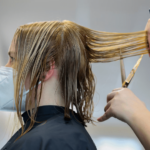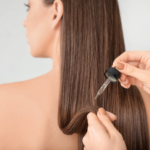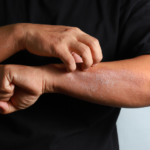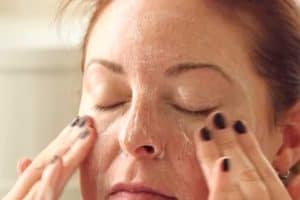Poison ivy is a plant that can cause a painful and itchy rash when it comes into contact with the skin.
The rash is caused by an oily resin called urushiol, which is found in the leaves, stems, and roots of the plant.
When urushiol comes into contact with the skin, it can cause an allergic reaction that results in a red, itchy rash.
The rash caused by poison ivy can vary in appearance depending on the severity of the reaction. In most cases, the rash appears as red, swollen, and itchy bumps or blisters.
The rash may also be accompanied by other symptoms such as itching, burning, and pain. In severe cases, the rash may spread to other parts of the body and cause swelling and difficulty breathing.
It is important to avoid scratching the rash, as this can cause it to spread and lead to infection.
If you come into contact with poison ivy, it is important to wash the affected area with soap and water as soon as possible to remove any urushiol that may be on the skin.
It is also important to avoid touching any other parts of the body with the affected area and to wash any clothing or objects that may have come into contact with the plant.
If the rash is severe or accompanied by other symptoms, it is important to seek medical attention.
Identifying Poison Ivy

Poison ivy is a plant that can cause an itchy rash when it comes into contact with skin. Knowing how to identify poison ivy is important for avoiding contact with this plant.
Leaves
One of the most recognizable features of poison ivy is its leaves. They are typically a glossy green color and grow in clusters of three. The leaves have a pointed tip and a serrated edge. However, it’s important to note that the shape and size of the leaves can vary depending on the age of the plant and the environment it’s growing in.
Stems and Roots
The stems of poison ivy are typically gray or brown in color and can have a hairy appearance. The plant also has aerial roots, which are thin, hair-like structures that help it attach to surfaces. The roots of poison ivy are typically shallow and spread out horizontally, rather than growing deep into the ground.
Berries and Flowers
Poison ivy produces small, white or greenish-yellow flowers in the spring. These flowers eventually give way to green berries, which turn white or yellow as they ripen in the fall. However, not all poison ivy plants produce berries.
Identifying Poison Ivy
One common saying to help identify poison ivy is “leaves of three, let it be.” This refers to the fact that poison ivy leaves grow in clusters of three. However, it’s important to note that not all plants with three leaves are poison ivy. Some harmless plants, such as clover and wild strawberry, also have leaves that grow in clusters of three.
To positively identify poison ivy, it’s important to look at all of the plant’s features, including the leaves, stems, and roots. If you’re unsure whether a plant is poison ivy, it’s best to err on the side of caution and avoid touching it.
Toxicodendron radicans
Poison ivy is also known by its scientific name, Toxicodendron radicans. This name can be helpful when trying to positively identify the plant. However, it’s important to note that other plants in the Toxicodendron genus, such as poison oak and poison sumac, can also cause an itchy rash.
Overall, identifying poison ivy requires a careful examination of the plant’s leaves, stems, and roots. By knowing what to look for, you can avoid contact with this plant and prevent an itchy rash.
Exposure to Poison Ivy

Poison ivy is a plant that grows in many parts of the United States and is often found in wooded areas, fields, and along roadsides. It contains an oily resin called urushiol that can cause an allergic reaction in most people who come into contact with it.
Direct contact with poison ivy is the most common way to develop a rash. This can happen by touching the leaves, stems, or roots of the plant. The urushiol oil can also be transferred to the skin by rubbing against clothing, shoes, or pets that have come into contact with the plant.
Hiking and camping in areas where poison ivy is present can increase the risk of exposure. It is important to stay on designated trails and avoid touching any plants. If you do come into contact with poison ivy, washing the affected area with soap and water as soon as possible can help remove the urushiol oil and prevent a rash from developing.
Equipment such as gardening tools, sporting equipment, and camping gear can also harbor urushiol oil and cause a reaction if not properly cleaned. It is important to thoroughly wash any equipment that may have come into contact with poison ivy.
Wearing protective clothing such as long pants, long-sleeved shirts, and gloves can also help prevent exposure to poison ivy. It is important to avoid touching the face or other sensitive areas of the body while wearing protective clothing, as the urushiol oil can still be transferred to these areas.
Overall, it is important to be aware of the presence of poison ivy when spending time in the great outdoors. Taking precautions such as staying on designated trails, wearing protective clothing, and washing any equipment that may have come into contact with the plant can help prevent exposure and minimize the risk of developing a rash.
Symptoms of Poison Ivy Rash
Poison ivy rash is a type of contact dermatitis that occurs when your skin comes into contact with the oil called urushiol found in poison ivy, oak, and sumac. The rash can be uncomfortable and itchy, and it can last for several days to weeks. Here are the common symptoms of poison ivy rash:
- Rash: The first symptom of poison ivy rash is the appearance of a red, itchy rash on the skin. The rash may be in the form of streaks, patches, or bumps, and it may be accompanied by small blisters.
- Swelling: The affected area of the skin may become swollen due to the inflammation caused by the rash.
- Itching: The rash can be very itchy, and it may cause a lot of discomfort to the affected person.
- Blisters: The rash may also cause small blisters to appear on the skin, which can be filled with fluid.
- Redness: The affected area of the skin may become red due to the inflammation caused by the rash.
- Inflammation: The rash can cause inflammation of the skin, which can make the affected area feel warm and tender to the touch.
- Fever: In some cases, poison ivy rash may be accompanied by a low-grade fever.
Poison ivy rash is not contagious, but it can spread to other parts of the body if the oil from the plant is transferred to other areas of the skin. It is important to avoid scratching the affected area of the skin as it can cause the rash to spread further.
If you suspect that you have come into contact with poison ivy, it is important to wash the affected area of the skin with soap and water as soon as possible to remove the oil from the plant.
Causes of Poison Ivy Rash
Poison ivy rash is caused by an allergic reaction to the oil called urushiol found in poison ivy, poison oak, and poison sumac plants. Urushiol is found in the leaves, stems, and roots of these plants and can remain active on any surface that comes into contact with it, including clothing, tools, and even pet fur.
When a person comes into contact with urushiol, it can cause a reaction on the skin within 12 to 72 hours. The severity of the reaction depends on the person’s sensitivity to urushiol and the amount of exposure they have had.
Not everyone is allergic to urushiol, but those who are can experience a range of symptoms, including redness, itching, swelling, and blisters. The severity of the reaction can vary from person to person and can range from mild to severe.
It’s important to note that the rash itself is not contagious and cannot be spread from person to person. However, it is possible for the rash to spread to other parts of the body if the urushiol oil is not washed off properly or if contaminated clothing or objects are not cleaned.
To prevent poison ivy rash, it’s important to avoid contact with poison ivy, poison oak, and poison sumac plants. If contact cannot be avoided, protective clothing such as long sleeves, pants, and gloves should be worn. If exposure does occur, it’s important to wash the affected area with soap and water as soon as possible to remove any urushiol oil that may be present.
Preventing Exposure to Poison Ivy

Poison ivy is a plant that can cause an itchy, red, and blistering rash when it comes into contact with the skin. To avoid getting a rash, it is important to take steps to prevent exposure to poison ivy.
One way to prevent exposure to poison ivy is to wear protective clothing. This can include long sleeves, pants, and gloves. It is also important to wear shoes that cover the feet, as poison ivy can grow on the ground.
Another way to prevent exposure to poison ivy is to use herbicides to kill the plant. This should only be done by someone who is trained in the use of herbicides, as they can be dangerous if not used properly.
During the summer months, when poison ivy is most active, it is important to be aware of your surroundings and avoid areas where poison ivy is known to grow. If you do come into contact with poison ivy, it is important to wash the affected area as soon as possible to remove the oils from the plant that can cause the rash.
If you are working in an area where poison ivy is present, it is important to clean your tools and clothing after you are finished. This can help prevent the spread of the oils from the plant to other areas.
Treating Poison Ivy Rash
If someone has come into contact with poison ivy and developed a rash, there are a few ways to treat it.
Wash the Affected Area
The first step in treating poison ivy rash is to wash the affected area with soap and water. This helps remove any remaining urushiol oil, which is what causes the rash. It’s important to wash the area as soon as possible after exposure to minimize the spread of the oil.
Over-the-Counter Treatments
Over-the-counter treatments can help relieve the itching and discomfort of poison ivy rash. Calamine lotion can be applied directly to the rash to help soothe the skin and reduce itching.
Antihistamine pills can also help reduce itching and swelling. Hydrocortisone cream can be used to reduce inflammation and itching. Oatmeal baths or oatmeal-based lotions can help soothe the skin and reduce itching as well.
Prescription Medications
If the rash is severe or widespread, a doctor may prescribe prescription medication. Antibiotics may be prescribed if the rash has become infected. Prescription-strength antihistamines or corticosteroids may also be prescribed to reduce itching and inflammation.
Home Remedies
There are several home remedies that may help relieve the symptoms of poison ivy rash. Applying a cold compress to the rash can help reduce itching and swelling. Aloe vera gel can also be applied to the rash to soothe the skin. Baking soda or colloidal oatmeal can be added to a bath to help reduce itching.
Medical Care
If the rash is severe or spreading rapidly, it may be necessary to seek medical care. Urgent care centers, primary care doctors, and telehealth services can all provide treatment for poison ivy rash. In some cases, a referral to a specialist may be necessary.
When to Seek Medical Attention

Most cases of poison ivy rash can be treated at home with over-the-counter remedies and self-care measures. However, in some cases, seeking medical attention is necessary. Here are some signs that indicate you need to see a doctor:
- Difficulty breathing: If you have difficulty breathing, wheezing, or tightness in your chest, seek medical attention immediately. These symptoms may indicate a severe allergic reaction, which can be life-threatening.
- Infected rash: If your rash becomes infected, you may need antibiotics to treat the infection. Signs of an infected rash include pus, yellow scabs, and tenderness or itching that gets worse.
- Fever: If you develop a fever over 100 degrees F (37.8 degrees C), it may be a sign that your body is fighting an infection. In this case, seek medical attention to get a proper diagnosis and treatment.
- Headache: If you experience a headache, it may be a sign that your body is reacting to the poison ivy. A headache can also be a symptom of an infection. If your headache is severe or accompanied by other symptoms, seek medical attention.
- Large rash: If your rash covers a large area of your body, it may be a sign that you need medical attention. A rash that covers your eyes, mouth, or genital area can also be a cause for concern.
- Mild cases: If your rash is mild, you may not need to see a doctor. However, if your rash is not improving after a few days of self-care measures, or if it is spreading rapidly, seek medical attention.
- Ointments not working: If over-the-counter ointments are not helping to relieve your symptoms, you may need a prescription-strength ointment from a doctor.
Remember, if you are unsure whether you need medical attention, it is always better to err on the side of caution and seek medical advice. Poison ivy rash can be uncomfortable and irritating, but with proper treatment, it can be managed effectively.
To Summarize
In summary, poison ivy rash is caused by an allergic reaction to an oily resin called urushiol. It can be found in poison ivy, poison oak, and poison sumac. This oily resin is very sticky, so it easily attaches to your skin, clothing, tools, equipment, and pet’s fur. You can get a poison ivy reaction from touching the plant or any object that has come in contact with it.
Symptoms of poison ivy rash develop anywhere from 1 to 7 days after exposure, depending on how much urushiol is present, the skin’s thickness, and how sensitive the person is. The rash may begin appearing within 12 hours, and it can take a few days to fully develop. Its severity varies from person to person, and it can range from mild to severe.
A poison ivy rash has the following features:
- Itching
- Painful blisters or vesicles filled with fluid
- Red bumps that appear in straight lines or streaks
- Swelling
While rare, some people see black spots instead of a red rash on their skin. These spots look like black lacquer spilled onto the skin. It is important to avoid scratching the rash as it can cause infection.
Treatment options for poison ivy rash include over-the-counter creams, such as calamine lotion, hydrocortisone cream, and oatmeal baths. In severe cases, prescription medication may be necessary. In addition, it is important to wash any clothing, tools, or equipment that may have come in contact with the plant or resin to prevent further exposure.
Overall, it is important to be aware of the appearance and symptoms of poison ivy rash to prevent exposure and seek treatment if necessary.








![Read more about the article How to Get Dead Skin Off Lips [6 Natural Remedies]](https://skincaregeeks.com/wp-content/uploads/2021/04/how-to-get-dead-skin-off-lips-300x200.jpg)
